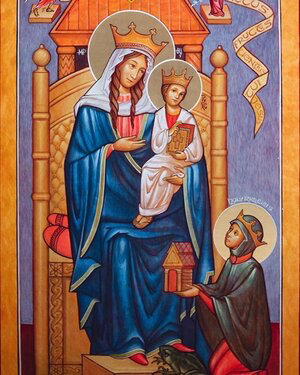unless otherwise stated.
Saturday after Ash Wednesday.
Station at Saint Tryphon's
(now at Saint Augustine's).
Indulgence of 10 Years and 10 Quarantines.
Violet Vestments.
English: The Church of Saint Augustine, Rome.
Italiano: San'Agostino, Rome.
Photo: October 2005.
Source: Own Work.
Author: Lalupa
(Wikimedia Commons)
The Station at Rome was, previously, at The Church of Saint Tryphon, who died a Martyr in The East. This Church having been destroyed, The Station was removed, under Pope Clement VIII, to a neighbouring Church, that of Saint Augustine. [Editor: The Church Commemorates The Feast Day of Saint Tryphon on 10 November.]
The High Altar,
Sant'Agostino, Rome.
Photo: July 2007.
Source: Own work.
Author: SteO153
Permission: CC-BY-SA-2.5
(Wikimedia Commons)
Saturday is the day of rest, which symbolises The Eternal Sabbath (Epistle of The Mass of The Day). To reach it, we must, during Lent, struggle by "Solemn Fast" (Collect of The Mass) and by Works of Charity (Epistle) against our passions, of which the rough sea and the contrary winds, spoken of in the Gospel, are a figure.
In this hard struggle, Jesus will come to our aid (Postcommunion), as He did to The Apostles and "heal our bodies and our Souls by Fasting." (Collect), as He healed all the sick in the country of Genesareth.
Mass: Audívit Dóminus.
Preface: For Lent.
The Altar and Tomb of Saint Monica of Hippo,
at Sant'Agostino in Campo Marzio Church, Rome.
Photo: March 2011.
Source: Own work.
Author: Bocachete
(Wikimedia Commons)
The following Text is from Wikipedia - the free encyclopædia.
Sant'Agostino is a Church in Rome, Italy, not far from Piazza Navona. It is one of the first Roman Churches built during The Renaissance. The construction was funded by Guillaume d'Estouteville, Archbishop of Rouen and Papal Chancellor. The façade was built in 1483 by Giacomo di Pietrasanta, using Travertine taken from The Colosseum. It is a fine, plain work of The Early-Renaissance Style.
The most famous work of art, presently in the Church, is The Madonna di Loreto, an important Baroque painting by Caravaggio. The Church also contains a Guercino canvas of Saints Augustine, John the Evangelist and Jerome; a fresco of The Prophet Isaiah by Raphael; and the statues of The Virgin and Child, by Andrea Sansovino and of The Madonna del Parto (Our Lady of Childbirth) by his pupil, Jacopo Sansovino. The latter sculpture is reputed by Tradition to work miracles and was, according to a legend, based on an ancient statue of Agrippina holding Nero in her arms.
In 1616, the 17th-Century Baroque artist, Giovanni Lanfranco, decorated The Buongiovanni Chapel (in the Left Transept) with three canvasses and a ceiling fresco of The Assumption. The Church also houses Melchiorre Caffà's sculpture "Saint Thomas of Villanova Distributing Alms", completed by his mentor, Ercole Ferrata. Pietro Bracci designed and sculpted the polychromatic tomb of Cardinal Giuseppe Renato Imperiali (1741).
English: “Madonna di Loreto”, by Caravaggio
Deutsch: Altargemälde der Cavaletti-Kapelle in Sant' Agostino in Rom,
Szene: Madonna der Pilger.
Date: 1603 - 1605.
Current location: Church of San'Agostino, Rome.
Source/Photographer: The Yorck Project: 10.000 Meisterwerke der Malerei.
DVD-ROM, 2002. ISBN 3936122202
Distributed by DIRECTMEDIA Publishing GmbH.
Permission: [1]
(Wikimedia Commons)
The Church contains the tomb of Saint Monica, mother of Saint Augustine, and that of Fiammetta, lover of Cesare Borgia and a famous courtesan.
Sant'Agostino was once noted for the presence of a number of courtesans and prostitutes in its Congregation.
The Titulus S. Augustini is held by Cardinal Jean-Pierre Ricard since 2006. Furthermore, it is The Station Church of The First Saturday in Lent.



































